#Tokyo Game Show 2008
Text
Some WLW (?) Jdrama & Kdrama recommendations!
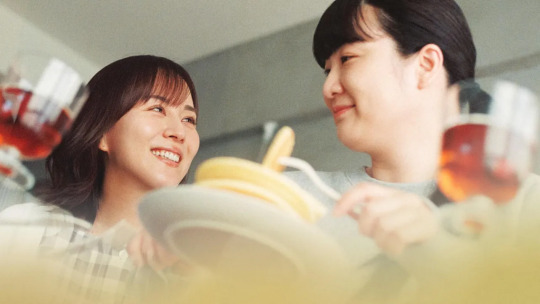
Jdramas and Kdramas have a (not-entirely-unearned) reputation for being very straight, but here are a few which are either canonically F/F or which prominently feature a female-female pair-- please enjoy! For those who enjoy following series in real time, Chaser Game W and She Loves to Cook, and She Loves to Eat S2 are both airing this January 2024 :)
As with my post on anime with yuri subtext, since subtext is so subjective, this list only includes series which I’ve actually watched, and so is by no means intended to be comprehensive. Also, it doesn't include any webseries, since those probably deserve a post of their own.
At-a-glance list:
Miss Sherlock (8 episodes, 2018) (subtext)
Night Light (20 episodes, 2016) (subtext)
Tokusatsu Gagaga (7 episodes, 2019) (subtext)
Painter of the Wind (20 episodes, 2008) (canon?)
She Loves to Cook, and She Loves to Eat (10 15-minute episodes and counting, 2022~) (canon)
Sono Toki, Heart wa Nusumareta (5 episodes, 1992) (canon)
Chaser Game W (10? 30-minute episodes, 2024) (canon)
Doctor X (7 seasons and counting, 2012~) (subtext)
Bonus: SKY Castle (20 episodes, 2018) (subtext)
Summaries under the cut!
1. Miss Sherlock / ミス・シャーロック (8 episodes, 2018) (subtext) – MyDramaList | AsianWiki

The elevator pitch for this show is simple: it’s Sherlock Holmes, but where Holmes and Watson – here named “Sherlock” and Tachibana Wato, and played by Takeuchi Yuko and Kanjiya Shihori, respectively – are both female, and the cases are all set in modern Tokyo. As with other adaptations, mystery-solving and the budding relationship between the two leads takes centre stage, but Miss Sherlock manages to carve out an identity all its own.
There’s a calm beauty to its visuals, which favour sunlight and urban greenery, and the show’s focus on former doctor Wato as she tries out new jobs and goes to therapy means that there’s a surprisingly high number of slice-of-life scenes. It’s also subtly more female-focused than the source material; Sherlock’s gossipy but good-natured landlady Ms. Hatano (Ito Ran) is as much a member of the household as Sherlock and Wato, and the cases often revolve around female characters. But more than anything, it’s just really fun to watch Sherlock and Wato’s relationship bloom as they snip and snipe and are utterly unable to stay out of each other’s space (literally – the body language and blocking is *chef’s kiss*). Their relationship is the heart of the show – watch this one until the end, you won’t regret it!
(CW: psychological abuse, manipulation, and genre-typical murder, violence, and gore)
2. Night Light / 불야성 (20 episodes, 2016) (subtext) - MyDramaList | AsianWiki
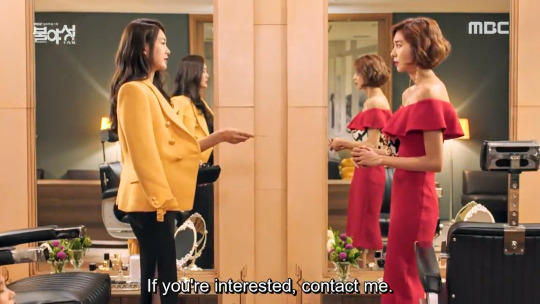
(Note: spoilers for the mid-season twist, but it’s impossible to allude to a good portion of the F/F subtext without doing so, and I think knowing the twist ahead of time doesn’t make it any less enjoyable.)
Night Light is a rather odd show. It’s simple enough on the face of it, a story about successful but ruthless CEO Seo Yi-kyung (an icy Lee Yo-won) who tries to mold the younger Lee Se-jin (a puppy-eyed Uee) in her own ambitious image, only for her protege to develop the conscience she never had and move to stop her dastardly plans… but upon watching it’s a totally different creature, thanks to the alchemic reactions of some delightfully contradictory acting choices (Uee’s performance convinces viewers less of Se-jin’s supposed latent desire for power and money, and more of a deep love and devotion for the CEO) and the unintentionally (?) inneundo-laden script (“If I like something once, I never forget it– whether it’s a dress… or a person,” declares the CEO less than ten minutes into the first episode while gazing intently at Se-jin).
Honestly, it’s a wonder this series ever got made, but you certainly won’t see me complaining! The first part is full of boss/subordinate goodness; Se-jin is unable to resist the CEO’s magnetic pull despite her hot-and-cold behaviour, while the CEO cannot bring herself to push Se-jin away completely. And then, when Se-jin makes her mind up to stop the CEO, it morphs into a corporate take on a (subtextual) lovers-on-opposite-sides situation, where it is precisely Se-jin’s feelings for the CEO that motivate her to stop her. In short, it’s a workplace GL fan’s dream.
Note: If you do watch it, skip the corporate politicking cutscenes with the old men, you’ll thank me later. Also, there’s a prominent male character who is the CEO’s ex and who works closely with Se-jin in the second half, but don’t worry, all the M/F romance is in the past (and doesn’t get much screentime)– he and Se-jin aren’t interested in each other at all.
3. Tokusatsu Gagaga / トクサツガガガ (7 episodes, 2019) (subtext) - MyDramaList | AsianWiki

Nakamura Kano (Koshiba Fuka) lives and breathes tokusatsu shows (think Power Rangers, if you’re not familiar), but keeps it a secret from her work colleagues to avoid being shunned or laughed at. And yet she yearns for connection, so when she sees a woman on the subway bearing a keychain from her favourite show (Yoshida Hisami, played by Kurashina Kana), she is determined to find her again.
Although ostensibly about being a tokusatsu fan as an adult, this show is rife with queer subtext, and not in the usual way. It deals with the difficulties of staying in the closet (regarding being an adult tokusatsu fan), the desire to connect with other queer people adult tokusatsu fans and how one might do so through hints and signals, parental disapproval arising from gendered and social expectations (that tokusatsu shows are for boys, and magical girl shows for girls), intersectionality and finding comradeship with other minorities people who are excluded due to their interests, and even generational gaps wherein younger queers fans may underestimate the obstacles that still exist. Although all that might sound a bit stressful, it isn’t actually! Difficult incidents are handled with sympathy and a dash of wry humour, and the show never loses sight of the fact that it – above all else – is a story about finding queer community in the face of a heteronormative hostile world, told with warmth and the nuance of lived experience.
4. Painter of the Wind / 바람의 화원 (20 episodes, 2008) (canon?) - MyDramaList | AsianWiki

Adapting the novel of the same name by Lee Jung-myung, Painter of the Wind takes as its protagonist a gender-bent version of real-life Joseon-era painter Shin Yun-bok (Moon Geun-young), whose paintings are used to weave a tale of artistry, political intrigue, and romance, and more than anything else to offer modern-day viewers a glimpse of everyday life in 18th-century Korea.
While it may sound like Dickinson’s boring cousin, apart from having a common preoccupation with reframing historical works, another similarity the two shows share is that Painter of the Wind is also very gay. Starting from the first episode, Yun-bok meets and becomes fascinated by the courtesan Jung-hyang (Moon Chae-won), who despite her initial aloofness is drawn to Yun-bok’s intellect and sensitive demeanour. It’s a real meeting of the minds, their witty repartee in early episodes reminiscent of Twelfth Night’s Viola and Olivia, and their relationship isn’t siloed off from the main plot either: Yun-bok’s infatuation quickly starts causing issues with her academic career, and the two eventually have to contend with Jung-hyang’s precarious position as a courtesan as well.
Unfortunately, all this is undermined in the back half of the show, which tries to gaslight viewers into thinking that Yun-bok’s feelings for Jung-hyang were purely platonic all along and that she totally has romantic feelings for her much older male mentor— but hey, at least it’s an open ending. Despite everything, though, I can’t think of another serious historical TV show which features such a prominent F/F narrative for its main character, even nearly two decades later. (Let me know if you have any others! And no, Gentleman Jack doesn’t count, it’s not exactly traditional in style!)
(CW: period-typical sexism)
5. She Loves to Cook, and She Loves to Eat / 作りたい女と食べたい女 (10 15-minute episodes and counting, 2022~) (canon) - MyDramaList
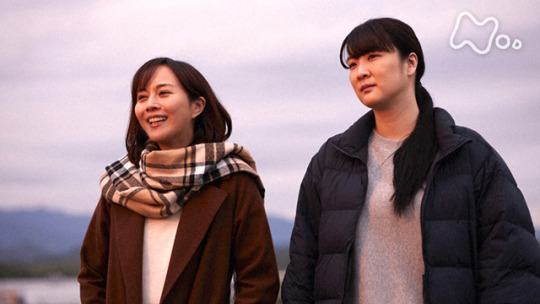
Based on Yuzaki Sakaomi’s manga of the same name, this simple but sweet show follows home-cooking extraordinaire Nomoto Yuki (Higa Manami), who yearns to cook large-scale dishes but doesn’t eat enough to justify making them. Luckily for her, her neighbour Kasuga Totoko (Nishino Emi) has a massive appetite!
It’s always lovely to see more grounded stories about working women, especially when they’re as cute as this one. Though it touches upon some slightly more serious issues, such as with regard to gendered expectations surrounding food and cooking, it’s primarily a feel-good slice-of-life show about two women getting to know each other by cooking and eating delicious food together.
Side note: if you’ve started it and think the show doesn’t look cosy enough, stick it out for a few more episodes, the production values improve after the first part! Also, the series was renewed for a second season with double the episode count (for a total of 20 episodes) which will start airing on January 29th this year, so this is the perfect time to jump in!
6. Sono Toki, Heart wa Nusumareta / その時、ハートは盗まれた (5 episodes, 1992) (canon) - MyDramaList
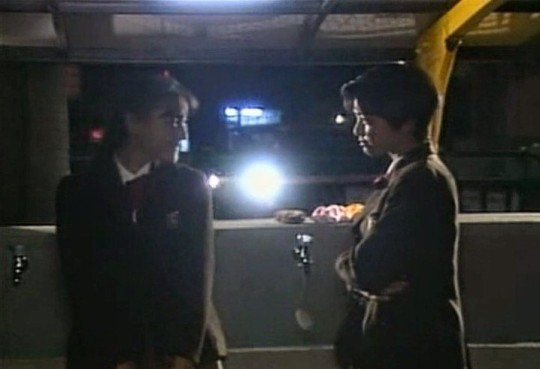
Sono Heart, as it’s nicknamed, starts off as a typical heteronormative high school romance: bumbling protagonist Shiina Hiroko (Isshiki Sae) is desperate to get closer to her crush Katase Masato (Kimura Takuya), star of the school basketball team and all-round nice dude. However, a spanner in the works comes slouching along in the form of female classmate Aso Saki (Uchida Yuki, in her debut role), a mischievous, short-haired personification of trouble who Katase turns out to have feelings for. One day, Hiroko gets into a fight with Saki, and they end up having to stay together after school as punishment. But that afternoon gives them the opportunity to bond over a heart-to-heart conversation, and things seem to improve… until, just before leaving, Saki kisses Hiroko. And then everything changes.
Or rather, everything changes eventually. What’s great about this show is that it doesn’t take shortcuts: Hiroko doesn’t instantly fall in love with Saki. Instead, what you get is a surprisingly layered portrait of a high school girl whose coming to terms with queerness is merely a natural extension of reckoning with her burgeoning sexuality. And, because Saki is self-destructive in her depression and makes a game of belittling, worrying, and infuriating anyone who cares about her, it’s really a story about what it means to love another person rather than a romantic ideal. A word of warning, though: Katase is actually quite a large character, as he and Hiroko end up becoming friends. Also, the ending is very abrupt and inconclusive, though rest assured that it doesn’t try to roll back Hiroko’s feelings, or pair either girl off with a guy.
(CW: self-harm, attempted suicide, bullying, homophobia, underage drinking)
7. Chaser Game W: Power Harassment Boss Is My Ex-Girlfriend / チェイサーゲームW: パワハラ上司は私の元カノ (10? 30-minute episodes, 2024) (canon) - MyDramaList | AsianWiki
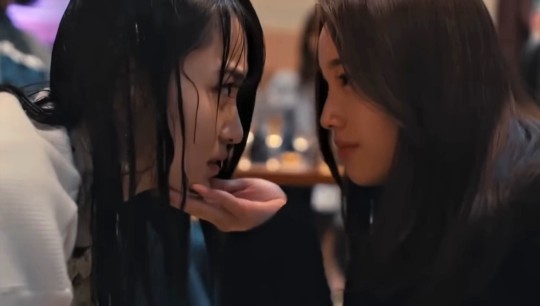
Probably jumping the gun here as only two episodes have aired as of writing, but I feel honour-bound to recommend this as it’d probably appeal to a lot of people, if only they knew about it! Chaser Game W is a standalone spin-off of Chaser Game, itself an adaptation of a manga of the same name by Matsuyama Hiroshi and Matsushima Yukitarou, but you don’t need to know anything going in.
Protagonist Harumoto Itsuki (former Keyakizaka46 captain Sugai Yuuka) has been assigned a new job: her company has been asked by a Chinese conglomerate to develop a game adaptation of a GL manhua, and she’s been tapped as the project leader. However, what appears to be an exciting prospect soon becomes a terrifying one, as the person sent by the client to supervise turns out to be her ex-girlfriend from university (Lin Dongyu, played by Japanese actress Nakamura Yurika), who is now married to a Chinese man (played by a Japanese actor) and has a child, but remains hell-bent on exacting revenge on Itsuki for their bad breakup. This is a romantic (melo)drama rather than a psychological thriller, though, so you won’t be watching Itsuki getting terrorised the entire time. While she is understandably upset by her ex’s current behaviour, Itsuki can’t forget about their happy days together, and Dongyu herself veers between being a sneering bully and craving Itsuki’s affection.
Do note that the show isn’t without its flaws: it’s very Japanese about the Chinese thing, which is to say it’s filled with comments which range from somewhat offensive to borderline racist, and the script will probably give you a headache if you know even the slightest thing about game development. Your mileage might vary on the ex too, as she can be really quite nasty to Itsuki and her teammates. But if you can overlook those issues, this is a rare prize indeed: a TV drama focusing on a canonical F/F pair, who are specifically exes, and in a workplace setting.
(CW: bullying)
8. Doctor X / ドクターX (7 seasons and counting, 2012~) (subtext) - MyDramaList | AsianWiki
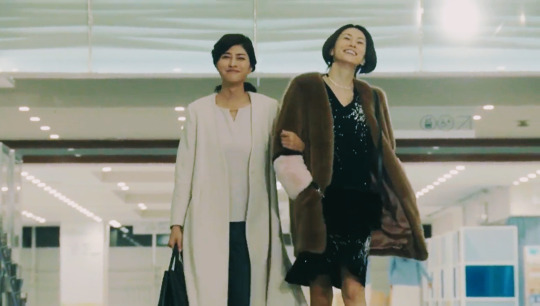
To be very honest, I was in two minds about including Doctor X on this list. It is, with a few notable exceptions, misogynistic and reductive in its depictions of women (especially in the first two seasons), gives too much screentime to objectively awful and subjectively annoying men, doesn’t respect the work done by medical personnel apart from surgeons, and on the technical front is formulaic, repetitive, and often lazy in its writing and presentation. Unfortunately, the dynamic between the genius surgeon protagonist Daimon Michiko (Yonekura Ryoko) and her anaesthesiologist wife partner friend Jounouchi Hiromi (Uchida Yuki) is almost unparalleled in its excellence.
The premise of the series is basic indeed: Daimon Michiko is a freelance surgeon with a healthy disrespect of rules and authority and, unluckily for her detractors, a cast-iron guarantee that she will succeed in any surgery, no matter how difficult. She’s initially portrayed as a lone wolf who’s dismissive of the entire hospital system and anyone who’s part of it— but her interest is piqued by the anaesthesiologist Jounouchi, who is skilled beyond her peers and chafes against the idiocy of her colleagues. For all its flaws, the first season – which is more serious and edgy in tone compared to the others, and isn’t an ensemble cast like the post-S3 seasons – is a fantastic depiction of two people being perfectly matched in skill, intellect, and outlook, and how they come together despite one being standoffish (Jounouchi) and the other not being used to reaching out to or even respecting other people (Daimon).
The seasons after that sadly ditch the emphasis on Jounouchi being Daimon’s professional equal, but in exchange offer up another rare and unexpected gift: two women in their late thirties / early forties who are partners both at work and in private. Jounouchi is Daimon’s designated anaesthesiologist, assisting with nearly every surgery, and she spends so much time at Daimon’s agency-office-slash-house you’d think she’d moved in. Also, after a point they just start being wonderfully dorky and comfortable with each other, while still being consummate professionals in the operating theatre. Although the show is very much focused on Daimon Michiko as its sole protagonist, Jounouchi is undoubtedly the character most significant to her – even more than Daimon’s father figure, the head of the freelance agency – and this is highlighted in the story from time to time. They are very, very good. I just wish the series was better.
Note: If you’re curious, I would recommend watching the very first episode in full– by the end you should know if you’re invested enough to continue, otherwise drop it and live in the happy knowledge that you dodged a bullet. If you aren’t so lucky, I’d advise skipping the surgery segments when they start to bore, and in general to skip liberally. Also, season 4 is not worth watching as a whole, except for the last two episodes, which absolutely should not be missed. Sigh. I can’t speak to seasons 6 and 7, due to having paused mid-S6.
Side note: If you’ve watched Doctor X already and liked it (or at least like Daimon and Jounouchi), but haven’t tried Miss Sherlock yet, definitely give that a go because there seems to be a big overlap in the fandoms. Maybe it’s because they both feature a genius protagonist, have the two largest female characters being work partners, and domestic vibes…?
(CW: sexism, genre-typical gore)
Bonus: SKY Castle / SKY 캐슬 (20 episodes, 2018) (subtext) - MyDramaList | AsianWiki

(Note: slight spoilers for the early episodes, but it’s necessary in order to give a more accurate recommendation regarding the F/F subtext, especially as the show is not primarily focused on any one relationship.)
This one’s a bonus because unlike the others on this list, there’s no close relationship between two female characters which could be interpreted in a romantic light. That’s not too surprising as the show is all about the women of a several super-wealthy families trying to get their children into the top Korean universities (equivalent to the Ivy League) whilst supporting their husbands in the rat race: a decidedly heteronormative premise, albeit one that’s executed in an award-winning manner.
So why am I listing it? Well, it’s because somehow, in this series about heteronormative and highly gendered nuclear families, it features possibly the most erotically-charged dynamic I have seen, even taking season 1 of Killing Eve into account. (Though it takes some time to get there, so if you try it out, please watch at least the first four episodes before making a decision!)
That honour goes to the problematic gem that is the relationship between the main character Han Seo-jin (Yum Jung-ah), who is willing to do whatever it takes to get her daughter into Seoul’s top medical school, and star tutor Kim Joo-young (Kim Seo-hyung), who is known for her 100% success rate. It starts off with a mild push-and-pull, when Han Seo-jin wants Coach Kim to take on her daughter, but is wary of the shady rumours surrounding her; the tutor stands firm, and Han eventually has to swallow her pride and accept the risks. Where it really comes into its own, though, is when Coach Kim starts to pose a legitimate threat to everything Han cares for: her daughter, her marriage (or rather, what her husband can give her), her position in the world. It becomes increasingly clear that Han should just walk away, and indeed she tries to do so many a time, only to bend in the end because the coach is key to fulfilling her dearest wish– and so to Han, for all she rages and resents and fears, Coach Kim is nothing less than temptation itself. This is the beating core of the show, and even as the plotting disintegrates and falls into melodrama in the second half, their scenes together still crackle with delicious tension every time. Watch it.
(CW: suicide, psychological abuse, child abuse, bullying, murder)
#kdrama#jdrama#sapphic#lesbian#gay#wlw#yuri#gl series#wlw series#she loves to cook and she loves to eat#tsukutabe#chaser game w#sky castle#doctor x#miss sherlock#night light#tokusatsu gagaga#painter of the wind#sono heart#list#wlw recommendations
479 notes
·
View notes
Text
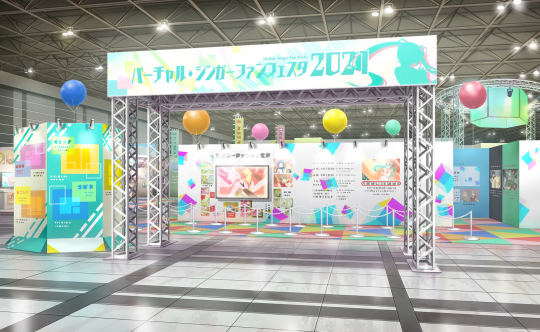

Only one date is ever mentioned in-game, that being 2021. Considering that the Virtual Singer Fan Festa seems to be a stand-in for Magical Mirai 2021, we can assume that the Scramble Fan FESTA! event takes place in September 2021 (the real-life MM2021 was delayed to November due to covid-19, but the pandemic doesn't exist in-universe and MM Tokyo usually takes place at the beginning of September). There are Leo/need Daily Life social media posts that show them attending Magical Mirai, and do state the year of the event, but these can be considered promotional material for the event itself rather than canon material, especially since the characters address in-game that only one year has passed since the start of the story (despite the fact they have celebrated new year's day 4 times now. Timeloop things).
Based on this date, we can actually place exactly when every main character was born. The cutoff date for Japanese schools is April 1st, making Ena the oldest main character, being a 3rd year with a birthday of April 30th, followed by Tsukasa on May 17th, so on so forth all the way down to Kohane, a 2nd year with a birthday of March 2nd.
Considering when Scramble Fan FESTA is set, Ena, who was a 2nd year at the time, would be 17 years old. That would place her date of birth as April 30th, 2004. Additionally, while Kohane, a first year at the time, should be 15 during the event, the game considers her to be 16 due to using a set age for every grade bracket. Regardless, the event setting places her date of birth as March 2nd, 2006.
Based on this, we can conclude that:
Ena, Tsukasa, Rui, and Shizuku were born in 2004
Mafuyu, Kanade, Airi, Minori, Saki, Toya, Nene, An, Ichika, Mizuki, Emu, Haruka, Honami, and Akito were born in 2005
Shiho and Kohane were born in 2006
This also means that Ena, Tsukasa and Rui are all older than the MEIKO software (released November 5th 2004), and everyone except Kohane is older than the KAITO software (released February 17th 2006). Every main character is older than Miku, the Kagamines, and Luka based on this information.
Using the information around set ages*, we can also work out rough estimates for when the side characters were born. For example, Arata, who was 19 during the first 3 years of the game, is 3 years older than the members of VBS who were all considered to be 16. Since the members of VBS were born in the April 2005 - April 2006 school year range, Arata was likely born in the 2002-2003 school year range.
* based on how characters like Youta and Miu, who are said to be the same age as Leo/need, were both confirmed to be 16 years old before the 3rd anniversary age-up. Also Haruka's age is confirmed as 16 at a point in time when she shouldn't be 16. Timeloop things.
Based on this, the oldest living side character, Kounosuke, who was 55 pre-3rd anniversary and 39 years older than Emu, was probably born between April 1966 and April 1st 1967. On the younger side of things, Hanano, who was 14 pre-3rd anni, was likely born between April of 2007 and 2008. I've put the rest of the estimated side character DOBs under the cut.
assumed age as of 3rd anniversary in brackets (literally just pre-age-up age + 1)
Rakunosuke Otori - April 2nd 1922 ~ April 1st 1923 (98 (at time of death. would be 100 if still alive))
Kounosuke Otori - April 2nd 1966 ~ April 1st 1967 (56)
Jean Riley - 1967~1968 (55)
Harumichi Aoyagi - 1968~1969 (54)
Shin'ei Shinonome - 1973~1974 (49)
Mr Yoisaki - 1975~1976 (47)
Ken Shiraishi - 1978~1979 (44)
Taiga Kotaki - 1978~1979 (44)
Yuuka Kazamatsuri - 1990~1991 (32)
Keisuke Otori - 1991~1992 (31)
Shousuke Otori - 1994~1995 (28)
Tatsuya Okazaki - 1999~2000 (23)
Ayaka Saito - 2001~2002 (21)
Hinata Otori - 2001~2002 (21)
Iori - 2002~2003 (20)
Mio - 2002~2003 (20)
Arata Tono - 2002~2003 (20)
Souma Miyata - 2002~2003 (20)
Kotaro Mita - 2004~2005 (18)
Sakurako Seiryuin - 2004~2005 (18)
Nanami "Nanamin" Hayakawa - 2004~2005 (18)
Futaba Natsuno - 2004~2005 (18)
Ayumi Tabata - 2004~2005 (18)
Hibiki Miyake - 2004~2005 (18)
Shuuta Hayashi - 2004~2005 (18)
Ibuki Taniyama - 2004~2005 (18)
Yuina Uchiyama - 2005~2006 (17)
Shouta Hayashi - 2005~2006 (17)
Miu Takagi - 2005~2006 (17)
Youta Yoshizaki - 2005~2006 (17)
Riho Hasegawa - 2005~2006 (17)
Saku Kousaka - 2005~2006 (17)
Mai - 2006~2007 (16)
Hanano Yoshizaki - 2007~2008 (15)
Ambiguous:
These ages were given in the 3rd fanbook, but there is not really any way to tell if these are the characters' ages at introduction or ages after the 3rd anniversary age-up. Here are both possible DOB ranges.
Mrs Asahina - 1980/81 or 1981/82 (41)
Yoshiki Shindou - 1982/83 or 1983/84 (39)
Yuuki Akiyama - 1999/2000 or 2000/01 (22)
Asahi Genbu - 2003/4 or 2004/5 (18)
Arisa Higure - 2004/5 or 2005/6 (17)
Additional notes (mod is rambling atp):
Rakunosuke died when he was 98 years old. In the WxS main story, Emu says that he died a year ago. Assuming Emu was 15 at the time, they have an age gap of around 83 years. The year of birth listed here was based on that assumption.
We know that Kanade's mother died aged 30, but we do not know when she died. She is still alive in flashbacks set roughly 10 years prior to the events of game.
We do not have confirmed ages for Nagi, Reki, Sakaki, MMJ's landlady or Mafuyu's father yet.
Rui suggests that Reki is the same age as him in A Story Where You Are The Star. However since it's more vague than Asahi, I left it out. However, Asahi was since confirmed as 18 when he was compared to Reki as being similar age, it is likely that Reki is also around 18 years old.
Nagi's age is left blank in the fanbook due to it not being revealed that she was dead at the time of publication. She is younger than Taiga, but we don't know by how much, but nonetheless she was likely born in the early 1980s.
No NPCs are given exact birthdays
#this post is an apology for the fact i never made a timeline when i said i would. sorry this is kinda confusing also#in short just know that we can assume that the game takes place in the 2021/2022 and 2022/2023 school years#don't use that as an excuse to be weird about the characters bc that's still the in-universe year(s) even if it's not the irl year.#this post is just for fun okay? okay.#project sekai#lore
333 notes
·
View notes
Text
Greg Cipes | Thursday, 01.04.24
Same voice actor, different characters - featuring Greg Cipes (happy birthday).
2003
Beast Boy (Garfield Logan) - Teen Titans (TV show/video games, 2003-2006)/Teen Titans: Trouble in Tokyo (movie, 2006)/New Teen Titans (mini-series, 2011-2012)/Teen Titans Go! (TV show, 2013-present)/Young Justice: Outsiders/Phantoms (TV shows, 2019-2022)
2004
Chiro - Super Robot Monkey Team Hyperforce Go! (TV series, 2004-2006)
2008
Kevin Ethan Levin - Ben 10: Alien Force (TV series, 2008-2010)/Ben 10: Ultimate Alien (TV series, 2010-2012)/Ben 10: Omniverse (TV series, 2012-2014)/Ben 10 (TV series, 2016-2021)
2012
Michelangelo - Teenage Mutant Ninja Turtles (TV series/video games, 2012-2017)
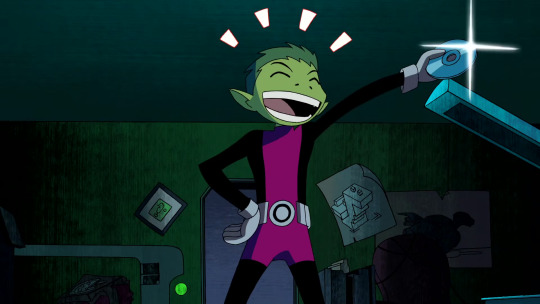
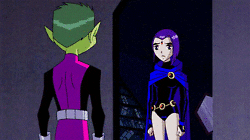




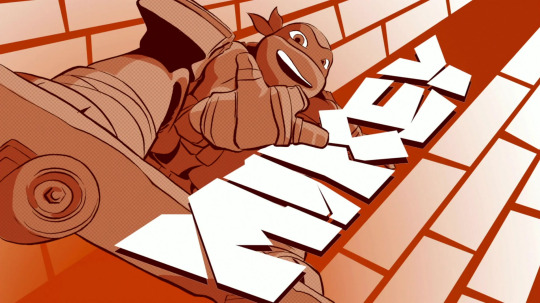

#anime iconography#beast boy#ben 10#ben 10: alien force#garfield logan#greg cipes#happy birthday#january#january 2024#january 4#kevin ethan levin#kevin levin#protagonists#reformed villain#same actor#srmthfg chiro#super robot monkey team hyperforce go!#teen titans#teen titans 2003#teenage mutant ninja turtles#throwback thursday#tmnt#tmnt 2012#tmnt 2012 mikey#tmnt mikey#tv series#tv shows#voice actor
23 notes
·
View notes
Text
I was always loosely under the impression that the first Olympic tie-in doll in the Barbie range was Olympic Gymnast Barbie for the 1996 Atlanta games, but as it turns out this is not the case.

The 1970s brought us "Gold Medal Barbie", including a range of different Olympic-themed outfits. To break down further, there were also a range of Barbies showing her and her friends competing in different events.
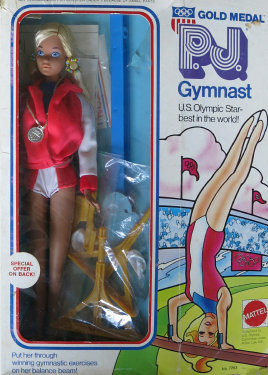

I believe, however, that Olympic Gymnast Barbie in 1996 was the first to be tied in to a specific Games, as well as the start of the trend of having Barbies representing the US in consecutive games going forward with specific tie-ins.

I have talked about Olympic Gymnast Barbie in many other posts before, because this is specifically a doll I remembered growing up with so she is always fresh in my mind.
If I talked about all the Summer and Winter Games tie-ins this would be such a long post that it would probably make people block on sight, so I'll save the Winter Games for a follow-up post.

Sydney 2000 had a wide range of dolls as tie-ins, including Swimming Champion Barbie, Paralympic Champion Becky, Olympic Fan Barbie and Olympic Pin Collector Barbie. There are probably several others as well that I have overlooked.
Barbie took a break again from the Games through 2004, 2008 and 2012 (though there are some non-Barbie fashion dolls produced by companies other than Mattel who are identified on reseller sites as a Barbie), making a kind of return in 2016 in a different way. Although there were no dolls that specifically tied into Barbie as a competitor, the 2016 Games inspired a few tie-in collectors Barbies in the likeness of specific Olympians.


Laurie Hernandez, a solo silver medalist and a team gold medalist gymnast at the Rio Games, and Ibtihaj Muhammad, bronze medalist fencer, were among the "Sheroes" honoured this way.

The 2020 (technically 2021) Games in Tokyo brought a new wave of Barbie competing as an athlete, in a variety of sports.


Most of her outfits heavily featured Barbie pink, alongside a Tokyo 2020 jersey.
No Barbies yet have dropped for Paris 2024, but I have to assume it is only a matter of time, as a range of athlete Barbies really fits with Mattel's branding of the doll right now.
25 notes
·
View notes
Photo
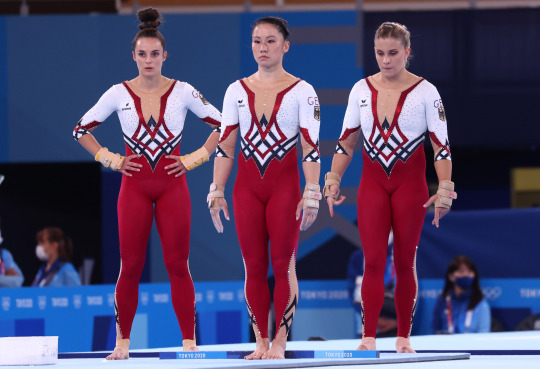
Let’s talk about German gymnastics...
The above picture is Pauline Schäfer-Betz (25--who has the amazing middle name of Sieglinde), Kim Bui (33), and Elisabeth Seitz (28). Between them they have been on 8 Olympic teams and Bui was an alternate for the 2008 team. Every so often someone in the gymternet (even the actual Gymter.net) will wring their hands and worry about the fact that Germany is leaning on these older athletes and be concerned that there aren’t people to replace them when they retire.
This is a cultural misreading of German gymnastics philosophy.
But to explain why let’s first start with these three amazing women. Schäfer-Betz was the 2017 World Champion on balance beam, and took a silver medal on beam at the 2021 World Championships, and bronze at the 2015 World Championships making her one of the most decorated beamers currently competing not named Simone Biles. She also is one of my favorite floor workers of all time. Schäfer is known for having lower difficult but winning with extremely clean execution (though she has a criminally under valued beam skill named after her that will looks impossible when you see it). @darthmelyanna calls it witchcraft which is rather fitting when you watch her beam choreography.
Eli Seitz has made 3 straight uneven bars finals (6th in London, 4th in Rio, 5th in Tokyo), having won a world medal on the bars in 2018 and came in 9th in the Tokyo Olympic all around. Here are her Olympic bars routines: 2012, 2016, 2020(1).
Kim Bui’s gymnastics resume isn’t quite as storied though she is a regular AA and event finalist at Europeans, Worlds, and Olympics and provides solid team scores. Here are her events from 2021 Europeans. To me she lovely to watch because of how much joy she brings to every performance, but the remarkable thing to know about Bui besides that she’s a high level international gymnast at 33 years old is that she has a masters degree in biomedical engineering and spends half her day in a laboratory doing cancer research. In case you were feeling accomplished about yourself today. Except Bui would tell you that you are doing great because she’s that kind of person.
These are not women who are “holding on”, they are still highly competitive athletes at the top of their game who are also leaders beyond their sport. In 2021 these three women began a movement in German gymnastics to show that gymnasts didn’t have to wear leotards but had other options if they didn’t feel comfortable. In their statements to the press they talked about not liking the kinds of pictures they found of themselves after competitions and the way people talked about their bodies rather than their sport.
Because gymnastics fans are used to seeing a name for a quad or two the fact that they see these three women consistently from Germany makes a lot of people reflexively assume that there aren’t those younger gymnasts that would replace them. The reality is that they are a core of a team that often includes younger gymnasts (who often also medal with non-Schäfer/Seitz/Bui Germans taking medals in 2016 and 2017. A lot of the handwringing compares the Germans to the Romanians who kept sending older great athletes to competitions while burning through young ones. I think this is a misunderstanding of the German program which emphasizes wanting longer sustainable careers rather than immediate medals. Seitz went to 12 straight world or Olympic games before finally taking a break for the 2021 Worlds (which was only months after the Olympics). Bui has had ACL injuries and come back better than she was before.
Gymnastics as a modern sport was born in Germany as both military training and philosophy for a whole and healthy life. The modern German program has jettisoned some of the... more problematic... elements of turner philosophy and embraced a modern one which I think they see Kim Bui and her scientist/world class athlete life as the example of. They are proud of their young talents but they want their young talents to be around for a very long time.
And I think a good example of this is going on this week at the European Youth Olympic Festival. A large multisport competition for juniors. Helen Kevric, who might be the single most exciting junior gymnast competing right now who will turn senior just in time for Paris, won the all around title and lead the German team to silver ahead of much more “traditional” gymnastics powers. She has 3 days straight of finals this week and on the first rather than throwing all the difficulty she was capable of which likely could have given Germany a gold medal she instead was allowed to throw slightly less difficulty to save her body not just for the next few days but for the next few years. The Germans took a silver today not because they lucked into it or because they weren’t good enough, but because sanity tells them that a single European Youth Olympic Festival gold is not worth unnecessary risk to a young athlete. Something that would be unthinkable in almost any other country.
Do not mistake people prioritizing sustainable careers for decline. I try not to get my heart set on juniors. So many of them never make it to the senior ranks or burn out early. I’m still holding by breath to see Kevric in Paris because she’s a stunning gymnast. But I am more confident that I will see her there than a junior from any other country. And I hope that in eight years I’ll still be writing about how amazing Helen Kevric is.
244 notes
·
View notes
Text

Information for Gyakuten Kenji (Ace Attorney Investigations: Miles Edgeworth) from Tokyo Game Show 2008.
Nintendo Power
Issue 236, Page 50
#Nintendo Power#Nintendo#Nintendo DS#2000s#Gyakuten Saiban#Gyakuten Kenji#Ace Attorney#Ace Attorney Investigations#Capcom#Tokyo Game Show
31 notes
·
View notes
Text
Terranort Speculation
It is known by know that when Birth By Sleep entered its earliest stages of conception and development (in 2006), Terra's story was thought out first (because Revenge of the Sith), followed by Ven's second and Aqua's last, explaining the recommended playing order. It's also shown in how in KHII FM, released in 2007, every single hook for BBS concerned Terra and his story - those horrendously misplaced scenes with Xemnas, Aqua's armor, Vexen, Zexion and Xigbar, the secret boss fight against Terra's Lingering Will, and the secret ending video where the climax is a close-up of Terra's face as his eyes morph into the "dark" golden eyes, or "Nort eyes." Then in 2008, early on at Jump Festa and later in at the Tokyo Game Show, the beta trailer footage for the former was only of Terra and Ventus while the latter added Aqua to the mix. And this was also the same time we got the 358/2 Days trailer and wow, between these teases and Coded starting up late into the year, 2008 truly was a year spent preparing the KH series for the plunge it was going to end up taking!
But I want to touch on all that early footage because it makes me speculate and believe that there was a slightly different plan set for Terra's story being developed at first, and that Terra himself was conecieved as a far darker character than what we ended up getting. Prior to contributions from Daisuke Watanabe and Masaru Oka, Nomura had every inclination to push as hard as possible with the "Anakin Skywalker" route for Terra, essentially taking what he had at first likely envisioned as being Xehanort's forgotten origin story and rewriting it with Terra in place of a younger Xehanort, making enough modifications to service the end point of Terra losing his heart and body to Master Xehanort, who'd lose his memory soon afterwards.
The thing about the beta trailers is that scenes that ended up occurring in the final product are played out in backdrops that were not intended to be the locations those scenes would actually play in (like, why's Xehanort confronting Ven at Olympus Coliseum? Why's Terra protecting Ven from Eraqus at the Great Maw? Why's Ven asking to be killed on Destiny Islands?) So while Terra's meeting with Maleficent was never meant to take place with thorns all around, what's really notable about how it's depicted here is...well, this:
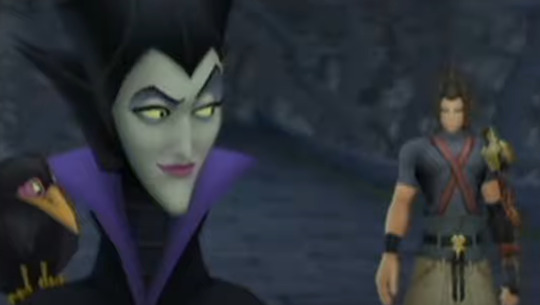
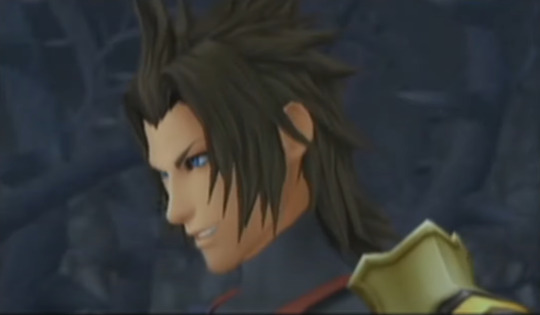
Maleficent clearly has a proposition for Terra, and Terra gives an evil Xemnas-y face in response. To me this suggests that in the initial plan, Terra at the start of the game was going to be like Riku was in the midsection of KH1: very easily allured by the power of Darkness and willing to dirty his hands while working with unsavory characters towards some goal he believed to be righteous and worth it for him.
Just as interesting, the second trailer has this next scene with Terra and Maleficent, as the latter exposits about the Princesses of Heart.

Literally nothing is different from the final scene except Terra's body language. In the final version, his head is titled towards Maleficent. But in this initial version, his head is tilted towards Aurora. Later in that same trailer, the last scene played sets up Aqua and Maleficent's later interaction different. Rather than ask "what did Master Xehanort tell you?", Aqua (with no Prince Philip there yet) asks "was what you said to Ven a lie?" And then Maleficent answers her straight up:
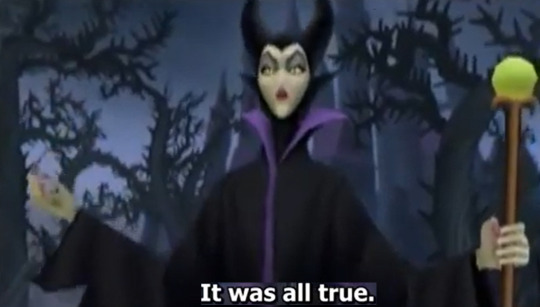

And yes, Terra's embrace of darkness during his confusion and rage over Eraqus' strict, abusive teachings of the supremacy of light over darkness does happen in the game, but it's framed as him getting tricked into it and extracting Aurora's heart by mistake, which is then later backtracked with Xehanort indicating he'd set up Aurora's heart to be extracted, making him the true culprit. I think in the original pitch, Terra was going to deliberately embrace the darkness and turn his Keyblade on Aurora's heart. He'd immediately regret what he did when he sees Maleficent claim the heart, but it would have been a far more willful mistake, which is why he'd be racked with such guilt over having done it. For a moment, he'd have crossed the line and done something evil, which someone who values heroism and protection of others like him would find completely antithetical to himself.
So then rather than further self-damnation like Riku in KH1, we'd see Terra walking back from the abyss in the next worlds he visits, giving us hope that he may yet avoid succumbing to the darkness within himself. .... And then the events at the Radiant Garden would occur, to set him down a different, even more insidious road to darkness.
Some time well afterwards, after he's come to blows with his friends and is in conflict with his master's agenda concerning him, after he's once again channeled his darkness and taken out Braig's eye, after he's been talked up by Master Xehanort, stirring within him the craving to seek more power, achieve more heroic exploits using that power, and wanting to protect his friends while also prove his master wrong and assert himself as the decider of how the trio should conduct themselves as Keyblade Wielders, and after he's far more willingly indulged his darker nature by working with more villains he'd always be dead-set on backstabbing whenever it's convenient for him and his "noble" goals to do so, we'd be treated to this moment:
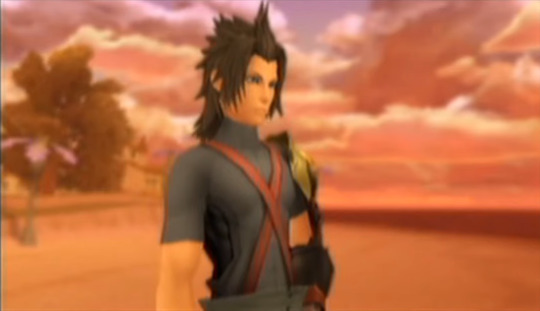


This plays much differently than anything we actually got from the stupid "Terra on Destiny Island" scene in the finalized game. To me, this is more like the also stupid first scene of the game with Young Xehanort, standing on the shore in contemplation as the bright sun sets over the horizon. Terra stands in solitude, away from the light, and when he sees the kids play-fighting on the beach, the sun is shining down and bathing them in light. Symbolism is clear; these are innocent hearts who belong to the light. Terra is no longer one such heart. He stands away from that brightness, away from light. This could've been the moment of realization from Terra that he needed to turn back from his darkness entirely, to head towards that light.
But alas. thanks to fucking Xehanort, this would follow instead:


This encapulates everything that Terra's character could've been. In the actual scene, the line is translated as "You may be my master... but I will not...let you hurt my friend!", to the response of "Has the darkness taken you too, Terra?" from Eraqus. But in the beta version, the wording suggests that the unseen Eraqus asks that question of Terra first, and Terra says "I don't care if you are my master! This power... I use it for my friends!" Conveying a full-on disowning of Eraqus as his master and a rejection of all that he'd taught him about light versus darkness, and an embrace of the power his darkness grants him to use for the sake of his friends. As in the final game, I think Xehanort would be the one to come in and kill Eraqus (gotta do the Mace Windu thing, after all), but in this version it would've been more clear that Terra was absolutely willing to kill his master here.
Beta Terra was meant to embody the absolute twisting of every positive value the KH Trinity showed us into a negative for him. "My friends are my power!" "My strength to become a True Hero comes from my friends!", "Our hearts are always connected", "No matter how deep the darkness, there's always a light at the end: keep your gaze towards that light even as you endure and exploit the powers of darkness from your own heart!" - Terra would showcase how you take those in the wrong direction, a callow young man ready and willing to try any measure, no matter how dark, in his pursuit of the "strength to protect what matters", his desire for self-actualization beyond what his master's expectations of him, and his committment to his more altruistic, heroic resolve (woah, major Alain flashbacks here!) We even see a carryover of this idea in Blank Points, where within Terra-Xehanort, Terra's heart tells Master Xehanort's heart that he's willing to get cast down into the deepest darkness and have his heart fully possessed by Xehanort so long as he feels certain that Xehanort will end up being the one to fade away into the darkness while Terra ends up returning to the light, and he does feel certain that this will be so for as long as he keeps sight of the cause he fights for: to return to his friends and make right what he'd helped set wrong, his heroic willpower embodied by that sentient armor spirit he'd left behind. But the follow-through on that is barely existent.
And the result is a man torn between himself: the man with the unbreakable will that desires to do good for the worlds and people he cares for (pure Terra, the Lingering Will), and the man who recklessly and selfishly embraces the heart's darkness for self-empowerment (Terranort, who'd later become a Heartless and create his own Nobody in doing so). By picking Terra to become his vessel, Master Xehanort would've basically ended up getting swept up in Terra's wild ride, as by becoming Terranort, he too became a fractured person, split into Ansem and Xemnas. Terranort was to be the ultimate villain because the "Terra" mattered as critically as the "Xehanort".
Tl:dr: I really like Terra, but at some point in his story's development he could've and should've been far more than a big dumb-dumb!
#Disney#Kingdom Hearts#Birth By Sleep#analysis#opinion#criticism#disney villains#Terra#Xehanort#Master Xehanort#what could have been#they wasted a perfectly good character#they wasted a perfectly good plot#anti birth by sleep#anti nomura#anti square enix
9 notes
·
View notes
Text
jean's films of 2023!
(r) = rewatch
Coming Home In The Dark (2021) ★ 06.01
1408 (2007) ★★½ 11.01
Baby Driver (2017) ★★★★½ 11.01
Along Came A Spider (2001) ★★½ 12.01
The Banshees of Inisherin (2022) ★★★★ 12.01
(r) The Twilight Saga: Breaking Dawn - Part 2 (2012) ★★ 13.01
The Guard (2011) ★★★½ 13.01
The Menu (2022) ★★★ 14.01
Don’t Look Up (2021) ★½ 15.01
(r) Barbara (2012) ★★★★★ 16.01
The Danish Girl (2015) no rating 17.01
(r) Carol (2015) ★★★★★ 17.01
(r) Glass Onion: A Knives Out Mystery (2022) ★★★★ 18.01
(r) Mamma Mia! (2008) ★★★★½ 19.01
My Policeman (2022) ★★½ 20.01
M3GAN (2022) ★★½ 22.01
The Girl on The Train (2016) ★½ 26.01
Empire of Light (2022) ★★★★ 27.01
Phoenix (2014) ★★★★★ 28.01
Videodrome (1983) ★★★★ 28.01
(r) The Favourite (2018) ★★★★★ 29.01
Red Eye (2005) ★★ 29.01
A Beautiful Day in the Neighborhood (2019) ★★★★½ 30.01
Badlands (1973) ★★★ 30.01
The Craft (1996) ★★★ 31.01
The Father (2020) ★★★★½ 02.02
TÁR (2022) ★★★★½ 03.02
(r) Open Season (2006) 03.02
Vivre Sa Vie (1962) ★★★★ 04.02
Rope (1948) ★★★★★ 05.02
(r) Carol (2015) ★★★★★ 08.02
(r) Ocean’s Eight (2018) ★★★★ 11.02
Do Revenge (2022) ★★ 12.02
The Wonder (2022) ★★½ 12.02
The Dig (2021) ★★★★★ 12.02
Nightcrawler (2014) ★★★½ 13.02
Valentine (2001) ★★½ 14.02
The Fabelmans (2022) ★★★★½ 17.02
But I'm a Cheerleader (1999) ★★★★½ 22.02
The X Files: Fight The Future (1998) ★★★½ 24.02
Dial M for Murder (1954) ★★★★ 25.02
(r) Paddington 2 (2017) ★★★★★ 25.02
(r) Carol (2015) ★★★★★ 26.02
Wild Strawberries (1957) ★★★★★ 01.03
Torso (1973) ★★ 02.03
The Lobster (2015) ★★★½ 03.03
Nimic (2019) ★★★★ 03.03
Disobedience (2017) ★★★★½ 04.03
Mad God (2021) ★★ 04.03
Road To Perdition (2002) ★★★★★ 05.03
The Lovers (2017) ★★½ 05.03
(r) Carol (2015) ★★★★★ 06.03
(r) Mamma Mia! (2008) ★★★★½ 07.03
Scream VI (2023) ★★ 12.03
Audition (1999) ★★★★ 19.03
(r) Carol (2015) ★★★★★ 19.03
Barbarian (2022) ★★★½ 21.03
Autumn Sonata (1978) ★★★★★ 22.03
Good Luck to You, Leo Grande (2022) ★★★★ 23.03
Tokyo Story (1953) ★★★★ 23.03
A Girl Walks Home Alone At Night (2014) ★★½ 24.03
Winter Light (1963) ★★★★ 24.03
Persona (1966) ★★★★½ 25.03
Best In Show (2000) ★★★★★ 26.03
(r) The Hunger Games (2012) ★★★★ 27.03
(r) The Hunger Games: Catching Fire (2013) ★★★★ 29.03
(r) The Hunger Games: Mockingjay - Part 1 ★★½ 31.03
(r) The Hunger Games: Mockingjay - Part 2 ★★★★ 31.03
The Blood of a Poet (1932) no rating 01.04
The Green Mile (1999) ★★★★ 01.04
(r) The Princess Diaries (2001) ★★★★ 03.04
The Princess Diaries 2: Royal Engagement (2004) ★★★ 04.04
(r) Brokeback Mountain (2005) ★★★★½ 04.04
Faces (1968) ★★★★ 05.04
(r) Blue Jasmine (2013) ★★★★ 07.04
The Town That Dreaded Sundown (1976) ★★★½ 08.04
Rebecca (1940) ★★★★½ 09.04
(r) Carol (2015) ★★★★★ 09.04
Dead Poets Society (1989) ★★★★ 10.04
The Life Aquatic with Steve Zissou (2004) ★★★★½ 13.04
Moonrise Kingdom (2012) ★★★½ 14.04
(r) The Life Aquatic with Steve Zissou (2004) ★★★★★ 15.04
All About Eve (1950) ★★★★★ 20.04
Bringing Up Baby (1938) ★★½ 21.04
Meshes of the Afternoon (1943) no rating 21.04
Shall We Dance (1937) ★★★½ 22.04
His Girl Friday (1940) ★★★ 28.04
Hour of the Wolf (1968) ★★★★½ 02.05
A Single Man (2009) ★★★★★ 04.05
(r) Carol (2015) ★★★★★ 04.05
Pearl (2022)★★★★ 05.05
X (2022) ★★ 06.05
(r) We Bought A Zoo (2011) ★★★★ 06.05
The Snowman (2017) ½ 06.05
(r) Terminator 2: Judgement Day (1991) ★★★★½ 07.05
Enys Men (2022) ★★★ 07.05
After the Rehearsal (1984) ★★★½ 09.05
Rosemary's Baby (1968) ★★★★½ 10.05
(r) But I'm a Cheerleader (1999) ★★★★½ 11.05
When Harry Met Sally... (1989) ★★★★½ 11.05
The Great Gatsby (2013) ★★★ 14.05
(r) All About Eve (1950) ★★★★★ 15.05
Heavenly Creatures (1994) ★★★★ 16.05
The Silence of the Lambs (1991) ★★★★½ 21.05
Legally Blonde (2001) ★★★★ 25.05
Waiting for Guffman (1996) ★★★★ 28.05
Funny Games (1997) ★★★★★ 29.05
#remaking the post because the old one is being weird#don't let me lose this one!!!!!#jeansfilms#there i'll remember that tag
23 notes
·
View notes
Text
“CLOUD message″ (2008) translations
Final Fantasy Agito XIII
p.57
Agito
This gripping tale follows the actions of a group of young soldiers during a world-encompassing war.
Among the three different Final Fantasy titles born from the singular mythology of the Fabula Nova Crystallis, FF Agito XIII stands out as the first Final Fantasy to be supported on a handheld game console. However, its hidden potential was much greater than imagined, and the footage that was shown at DKΣ3713 and Tokyo Game Show 2008 showed us some shocking developments. What is the "truth" there?
p.58
The Small Giant, Agito
When I saw the video at the DKΣ3713 event with its solemn, documentary-style narration and realistic war-like visuals, I honestly didn't know what game I was looking at. The content was so shocking that it overturned the game's image from the ground up. What had until now seemed like a relatively lighthearted RPG featuring keywords such as "magic academy", "school life", and "Crystal" suddenly did an about face. The video was presented as a "war chronicle" with a profound sense of depth, with words like "border invasion" and "war" being thrown around. So, was this video, which was release at the same time as the announcement of the PSP version of the game, intended to change the direction of FF Agito XIII? The answer is no. To support this, I will quote Nomura's statement.
"FF Agito XIII has a historical timeline which also mentions great wars of the ancient past, and when you take all of that into account, it has quite a considerable volume, so the content and image will change depending on where you place your focus."
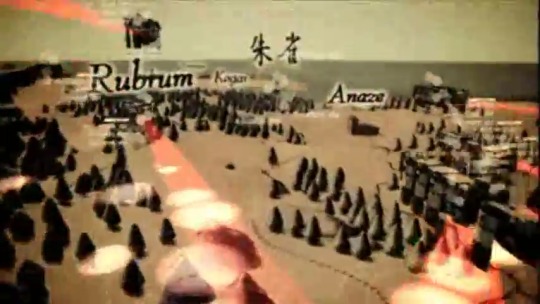
In other words, it will be a game with a completely different impression depending on which era and location is being spotlighted in the expansive timeline. The juxtaposition of "kanji cities" and "English cities" in the video seems to symbolize that reality and fantasy do not contradict each other in this world where school life and dark topics coexist without feeling out of place...
If Nomura's comment about "a world so vast that you can't see how far it can expand" is the essence of FF Agito XIII, then what we've seen of FF Agito XIII so far is just the tip of the iceberg.
p. 59
The Meaning of a FF That Everyone Can Play Easily
"This is not one chapter of a story. It is a history written by each person’s hand. It is destiny."
This line comes from the narration in the video. There are no words that could more succinctly express that FF Agito XIII is a game that everyone is meant to play together. In FF Agito XIII, there is no default protagonist nor predetermined story. This part is fundamentally different from FFXIII and FF Versus XIII. The main character is the player themselves, their friends are the other players who they connect with online, and each adventure you have with those friends is the story of FF Agito XIII.
When you think of a Final Fantasy that everyone can play together, FFXI comes to mind. However, because FFXI is a game for PC and home consoles, it can't be easily played everywhere. As the online space rapidly evolves, it could be considered inevitable that FF Agito XIII would choose PSP and mobile phones when looking for the best environment for everyone to play together.

Perhaps the performance of mobile phones will dramatically improve for playing games in the future. In addition to the established ad-hoc battles on the PSP, a service will be launched where players can form impromptu parties with distant players via the PS3. It seems as though everything is going according to plan. If that isn't the case, then I can only assume that something is being brought closer...
With these features, FF Agito XIII will be "a Final Fantasy that can easily be played by everyone," something which has been rarely seen in the series. In addition, this Final Fantasy will be supported by a grand world and setting. The future shown by this synergy... Will be the style of a new Final Fantasy.
p.58-59

What is FF Agito XIII to you?
"This is the first Final Fantasy I'll be working on from scratch. Since I have this opportunity, I'd like to do what I want as much as possible and play a big role in the FFXIII series."
Hajime Tabata, Director
"A grand world and setting that can be expanded forever, to the point where its limits cannot be seen."
Tetsuya Nomura, Creative Producer
"A Final Fantasy that aims to go beyond expectations."
Takatsugu Nakazawa, Planning Director
"Challenging the limits of the PSP."
Yusuke Naora, Art Director
In one word, how would you describe FF Agito XIII?
"A documentary-style war chronicle Final Fantasy that everyone can play together."
Hajime Tabata, Director
"Unexpected ambush."
Tetsuya Nomura, Creative Producer
"A Final Fantasy that can be played anytime, anywhere, any way."
Takatsugu Nakazawa, Planning Director
"A cutting edge Final Fantasy that everyone can play."
Yusuke Naora, Art Director
What makes FF Agito XIII different from other games?
"I think it's the fact that this is where numbered titles will be introduced to handheld consoles. Everyone on the project is eagerly working hard to deliver a serious Final Fantasy to the PSP."
Hajime Tabata, Director
"The great potential for the game to change freely in the future."
Tetsuya Nomura, Creative Producer
"There are too many differences to write!"
Takatsugu Nakazawa, Planning Director
"I think that the mismatch between tradition and stimuli will create a new taste."
Yusuke Naora, Art Director
#final fantasy#fabula nova crystallis#final fantasy agito xiii#final fantasy type 0#translation#cloud message
15 notes
·
View notes
Text
Animation Night 127: Project Itoh
Hi friends!
It’s Thursday - my last Thursday in America for the foreseeable future, in fact. On Monday I’ll be making a bizarre journey back to the UK via the ‘extremely direct’ route of Norway and Latvia, because it turns out that’s the cheapest way to get across the Atlantic. So that’s gonna be quite an adventure. I’m going to write some kind of post about things I’ve seen in America but probably when I get back for the sake of enjoying what time I’ve got left here...
Anyway, on to movies!
Tonight we’re going to be checking out a curious little sort-of trilogy of movies by different studies and directors from 2015, celebrating the works of the short-lived but influential science fiction author Satoshi Itō, aka Project Itoh.
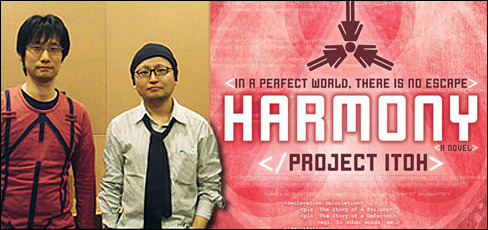
Here’s a picture of Itoh hanging out with his close friend Hideo Kojima at a book launch (via Metal Gear Trivia)
So who’s this Project Itoh guy? Born 1974 in Tokyo, there’s not a lot of biographical details about Itō’s early life, save that he went to Musashino Art University and worked as a web designer until the publication of his first novel, Genocidal Organ, in 2007.
What we do know is that he loved Metal Gear. Like, a lot. Itō got into Kojima’s games from the very start, and indeed most information about his life comes from Kojima’s account, alongside the blog where he published Snatcher and Metal Gear fanfic. The pair met at the 1998 Tokyo Game Show, at which Kojima was immediately struck by Itō’s devotion to his works, describing Itō as the one person who truly understand what he was writing about - an experience which ‘saved’ Kojima.
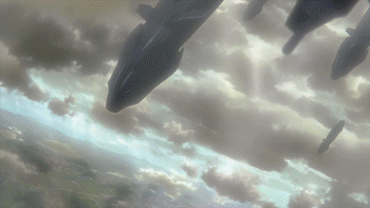
The two became close friends - and three years later, when Itō went into hospital with cancer in 2001, Kojima rushed to his bedside, and while there, showed him the first footage of MGS2: Sons of Liberty. Itō responded by promising he would not die until Kojima finished MGS2.
The experience of being hospitalised seems to have been very formative for Itō’s worldview. Youtuber The Canipa Project translates a blog post in which Itō talks about the experience of having his body sustained by scientific means only recently invented, making him a cyborg.
This time, Itō was able to keep his promise; when MGS2 came out, Itō wrote extensive analysis and exegesis of the game’s philosophical themes, getting a lot of attention within the fandom.
As the 2000s went on, it seems he judged it time to spread his wings and try releasing his own original stories under the pen name Project Itoh. The first, Genocidal Organ, was adapted from a fanfic he wrote about Snatcher into an original story. He submitted it to a novel writing competition in 2006, and while it didn’t win, he found a publisher in 2007; the novel became a hit, and so impressed Kojima that he asked Itō to take on the daunting task of writing a novelisation of Metal Gear Solid 4: Guns of the Patriots.

Itō apparently succeeded handily at the novelisation, and off these two successes, seemed set for a great writing career. His next novel, Harmony, dropped in 2008, dives straight into the themes of medical control; a dystopia in a post-nuclear war world where humans in the aftermath managed to cure cancer and most other diseases, only to institute a program of social control in an attempt to complete their utopia by eliminating mental illness as well. A story that’s clearly cutting pretty close to the bone from Itoh’s own experiences, since he was spending the 2000s dealing with recurrent cancer that took him back to hospital over and over.
And, indeed, the inevitable came in 2009, at which point Itō had just begun on his third novel Empire of Corpses. His cancer returned in force and he returned to hospital; once again Kojima went to his bedside and broke NDA to tell Itoh in detail about his next game, Metal Gear Solid: Peace Walker - that’s the odd PSP one featuring the Sandinistas. And once again, Itoh promised to live until Kojima finished the game, and write the novelisation of MGS3 and Peace Walker. But this time, it was a promise he could not keep; Itoh died at the age of 34.

In the wake of his death, a devastated Kojima dedicated Peace Walker to him (and later revealed he had planned to name as a successor following MGS5), and his friend Toe Enjoe took on the task of finishing Empire of Corpses. Once again, I’ll turn to Canipa Effect’s translation of some of the words Itō wrote three months before his death:
Humans dwell in others as a story. People can continue to live within someone else as a narrative. Then, by being part of the variety of spoken words, they become part of the fiction that can shape humanity.
(Words that resonate too strongly with the death of my friend Fall earlier this year.)
So far, a tragic story - but in some sense one with a slightly hopeful touch, in that rather than dying of cancer in 2001, Itō was able to enjoy eight more years of life and write several novels. But what has it got to do with animation?
Enter Noitamina (the word animation backwards), the late-night anime programming block run at the time by Koji Yamamoto as a means to get experimental, creative animation - such as Masaaki Yuasa’s adaptation of The Tatami Galaxy or Kenji Nakemura’s BakeNeko and Mononoke - out to a wider audience. Yamamoto departed the block in 2015, but in its heyday it was home to a number of radically creative works; you can read more about it over here on sakugablog in a recent post on the context behind The Tatami Galaxy.

So, in 2015, Noitamina announced it would fund three movie-length adaptations of Itoh’s three novels, each by a different studio and director. For all three movies, the character designer would be illustrator redjuice of the ‘band’ Supercell, a somewhat odd musical project consisting of just one musician and ten illustrators and designers who produce materials around the music.
Genocidal Organ would go to the hands of Shūkō Murase, at Studio Manglobe, a unique studio renowned for original works like Shinichirō Watanabe’s Samurai Champloo, Ergo Proxy, and Michiko & Hatchin (the latter of which I covered back on Animation Night 36). Murase seems like a natural choice for a highly philosophical cyberpunk story, given Ergo Proxy... but a spanner was thrown in the works when Manglobe went bankrupt; Genocidal Organ would eventually be saved by the resurrected Manglobe in the form of Geno Studio, but for this reason, it missed the planned simultaneous release of the three movies.
The story concerns a world in which a series of social breakdowns and genocides take place in a short period of time, all seemingly associated with an American named John Paul - who, when tracked down, claims to have discovered a ‘genocidal organ’ which can be activated to incite humans to acts of genocide. Without giving away too many spoilers, it’s basically about the current American-dominated geopolitical order.
On the animation side, the stars of the show would be Bahi JD, the Austrian from the earliest wave of sakuga fandom who became one of the first international ‘webgen’ animators to find a career in Japan... and Shūkō Murase himself, who animated several cuts as well as directing the film. As such, even a quick look at sakugabooru shows a lot of subtle, well-observed movement; I’m looking forward to seeing it fit together.

Harmony - the post-cancer dystopian one - went to Michael Arias at studio 4°C, of Tekkonkinkreet fame (see Animation Night 52 for Tekkonkinkreet, and Animation Night 74 for a more detailed history of 4°C), alongside veteran animator and director Takashi Nakamura who you may remember from the Chicken Man and Red Neck sequence of Robot Carnival. It comes at a point where 4°C had found a lot of comfort with their use of CG, two years before Mutafukaz (Animation Night 105), and even if the incredible background artists of Tekkonkinkreet may not be on this one, I imagine it will look pretty lavish as 4C stuff always does.
Then comes The Empire of Corpses. This one goes to Wit Studio (Animation Night 101), directed by Ryōtarō Makihara - also no stranger to scifi, with his main previous work being Hal, the story about a robot designed to play the role of a deceased partner. Unlike Itō’s other works, which are near-future science fiction, this one is more of a steampunk piece, taking place in an alternate 19th century in which mass produced Frankenstein’s monsters have become the industrial base of society; its characters bounce around the globe unearthing a conspiracy. It sounds kind of wild, honestly, with not just Frankenstein and Babbage but even frigging Sherlock Homes running around; Japanese spins on British characters like this are always kind of fascinating. (Also... there is some tragic irony about a story revolving around reanimated corpses being completed by Itō’s friend after his death.)
So, that’s the plan for tonight: we’re going to be watching all three Project Itoh movies, in the order that Itoh wrote them! I think there’s gonna be some great stuff in here, and I hope I’ve given you reasons to be excited too~
so, if you’d like to check these out, please make your way down to twitch.tv/canmom - we’ll be starting the program in about 20-30 minutes once people are in there!
27 notes
·
View notes
Text
Clerra hints in FF7 Rebirth so far
I have been wanting to continue writing more, but I was waiting for the script of Act 4 Chapter 7 Part 2 of DFFOO to release at dff.ooo, but that still hasn't happened...so I'll ignore it for now.
The demo footage from the Tokyo Game Show has arrived. I originally didn't expect anything, but it makes sense that the demo shows the flashback and Junon since they were shown in the trailers already.
Here's a list of general stuff followed by miscellaneous Clerra stuff (#7 is biggest):
Climbing is a part of this game.
You can swim in basically any source of water to reach islands.
Yuffie is recruited during the boss fight that involves Priscilla and it seems like the artificial respiration minigame will be done with Yuffie (?maybe?). They were playing it safe there I suppose.
A giant bird creature (i'll just call it "the condor") snatches one of the black cloaked figures. I feel there was always a hint that Zack should be snatched up by something bird-like and fall on some flowers thanks to what the WoFF DLC scene involving Serah showed (search it up on YouTube if you want) and the fact that the condor appeared before Zack's scene in Intergrade's ending (which is why I mention it). There is a little more information about birds and Shinra involving the "Fonadu" enemy. Also, Fort Condor is now an island (it's may be important for Clerra, but that's a long story).
Priscilla is similar to Rikku. In fact, I felt she was so similar that I can literally just say that my crazy theory has been proven right. Rikku is designed after Yuffie and Priscilla, which is why both of them are now involved in the same scene and already know each other. It may not seem important now, but if Rikku appears in DFFOO, it will be. Plus, it's "lore"...in a way. My original theory started with why the concept art of Priscilla looked similar to Rikku (specifically the hair) and why in X-2 Rikku says she once had a crush on someone which was never ever figured out to be anyone except one guy which couldn't possibly be (yes, it's actually Cloud, thanks Nomura).
Rhonda, the mayor for the town under Junon has clothing that is similar in composition to Terra. She has the pink cloak "scarf" around her neck, interesting earrings, a ponytail, and a piece of clothing wrapped around her waist mimicking Terra's sash. She has a tattoo on her left arm as well, but I didn't know what it was. I'd assume there'll be something involving her with this Clerra storyline in Cloud's timeline. The hair bangs of Tifa, Priscilla, and Yuffie are also similar...they may be imitating Cloud's hair in a way. This isn't a new thing since Terra's hair in Dissidia (2008) also imitates Cloud hair (it's very subtle, but you won't un-see it once you notice it and how it goes away in Dissidia NT). Another character will likely be Kyrie in Zack's timeline (and maybe Jessie again if she exists). Priscilla's hair and clothing look more like Terra's now.
The synergy attack with Cloud & Aerith ("Firework Blade") looks like Terra's "Riot Blade" attack from FF6 (three energy beams are shot from Cloud's sword)...however, the most important detail is extremely important. The attack has the 5-petal flower spammed into existence. This flower is always found on Terra's hints: the flowers on Miss Folia's shirt, a promotional Dissidia Arcade image with Cloud, Terra, and Onion Knight, on the New Year 2020 card with mouse Terra, and on Yuffie's clothing in Advent Children. I think this flower is one of the many 5-petaled ones on Terra's leggings.


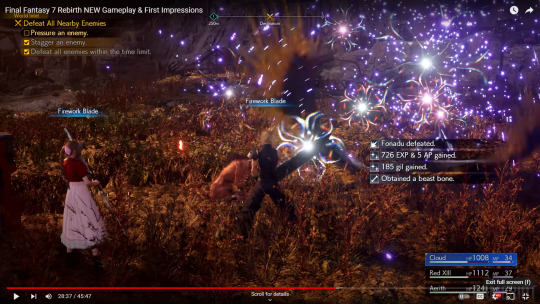


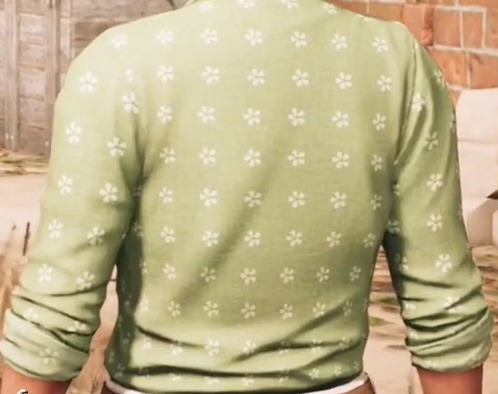

So, it looks like Riot Blade, and it only has this specific flower involved in it...this is the most important Clerra clue so far, period, in anything. Sure, it could just be a five petaled flower because it's Aerith's attack, but the main difference is that it is MANY. The Yuffie flower hint is very old, btw.
Now, about Zack's timeline...

In Zack's timeline, Elmyra hints that the world may be "ending". The tornado that destroys and incapacitates the others in that timeline is involved in the end of FF7 with Meteor coming close. The case may be that Zack's timeline is Sephiroth winning.
With Sephiroth's words at the end of the trailer, this means that instead of "going to another world", he will bring two worlds together (FF6 and FF7's worlds). This is hinted at in Opera Omnia where worlds actually are merged into one ALL THE TIME, although Sephiroth mentions he wants to travel to other worlds. It could be that Terra (and maybe others) will just appear in the world, but it seems a bit silly to think of it like that...for now (it was one of my original joke theories from early 2020).
Many people were surprised by what Sephiroth said about the Reunion being "worlds merging" and the general assumption is that the timelines are the worlds, but no one is anticipating anything related to Clerra despite all the hints that have been ignored.
The thing is, following the pattern, Cloud in his timeline is with Aerith doing the "FF7 game story". It makes sense that Zack would be doing the opposite thing with Terra in the "FF6 game story" that Cloud is missing from (as he's the original main character of FF6 and Zack was the originally planned "personality" of Cloud for FF7 before they decided on FF6 Cloud and made a big mystery on who's "the real Cloud").
I know that's hard for anyone to believe, but I guess you'll see for yourself...
Still, I don't know WHEN Terra will appear, but it's completely possible it will happen in Rebirth as all the puzzle pieces are set with Zack's timeline along with DFFOO chapter 4 is building up something and the hints are getting too strong for them to continue the secret for four or so more years. Also that Terra statue will be shipped soon that costs as much as a car...obviously, that can't be ignored (will it ship November 2023? I remember it being that.)
Many people like to focus on Cloud, Zack, and Sephiroth (theorists especially), but don't seem to notice that the three are distinctly tied to Terra, Aerith, and Jenova.
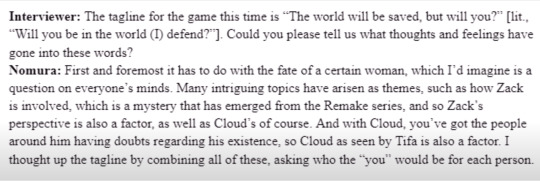
4 notes
·
View notes
Text
friendly reminder to new Persona 4 players from an old hat that the original P4 was developed in 2008. that’s a short fifteen years, and nothing was progressive back then. if you’re looking for the progressive stances on Kanji and Naoto that you might see in fandom, the game isn’t like that.
Japan itself wasn’t inherently homophobic like many western societies are but they also aren’t the golden country of LGBT rights. Heck Tokyo Pride has only been in since 2012.
But a small rural town like Inaba is in the game would be quite insulated from the rest of the country, especially back then. The Investigation Team only have flip phones and probably dial up internet.
Yosuke has moved there from Tokyo because his father took up Junes management and, while already an outcast due to Junes causing most of the family run businesses to close, he also likely has internalised a lot of comments and homophobia. Back in 2008 it was popular among teenagers to use gay as an insult to mean something like ‘that’s so stupid’ (heck when I was in high school back in 1997 that was popular). While he does get better as the game progresses forward he still has his moments, but noticeably after the cultural festival has dialed down his homophobic type comments to Kanji since being put through the drag show. Yu, coming from the same city as Yosuke six months later, probably has more of a grasp on things and doesn’t have that internalised hatred for himself like Yosuke has.
Teenagers in small rural towns don’t generally have a grasp on things that what would be considered today to be LGBTQ. If they do it’s because they got it from the internet and as we all know the internet isn’t that great a source, especially if the people you’re learning from are the wrong side of homophobic and use terms that you don’t understand. People back then would use terms like ‘strange’, ‘weird’ or ‘unusual’ to describe LGBT-leaning people, and even now I need to step on my mother’s foot when she uses ‘weird’ or ‘queer’ as a derogatory term.
Even Hanako gets the short end of the stick, not because she’s LGBT or anything (as far as we know), but because she is fat. Asian countries are notoriously fatphobic and I see comments on a mukbanger I watch where she’s like ‘I’ve put on weight :(‘ but she looks exactly the same as when I started watching her three years ago. It might be a thing that I don’t understand because I’m from the western countries but having faced fatphobic comments in my whole life, I take personal offence of Hanako’s portrayal and voice.
Anyway all this to say, don’t be surprised if the game doesn’t pander to your expectations of what Kanji and Naoto should be in your eyes compared to what they are in game. Take recent history into consideration when you play and don’t blame the developers.
#persona 4#persona 4 golden#this got long and anyone can feel free to add or pull me up on something if it doesn’t sound right#I’m working off 6 hrs of sleep and a full day of paperwork
9 notes
·
View notes
Text
Obscure Animation Subject #70: Momotaro Densetsu
Originally posted on Twitter on April 30, 2023.
Based on the video games by Hudson Soft, this show is produced by Knack Productions and aired on TV Tokyo from October 2, 1989 to April 1, 1991, running for two seasons with a total number of 75 episodes, each 22 minutes long.
This show’s characters are from Japanese folklore, and follows the adventures of Momotaro. This would be Knack’s final animated production until New Attacker You in 2008. Knack still exists today but isn’t interested in making shows anymore, and currently just a license holder.

2 notes
·
View notes
Text
saw a post earlier that was something about having people tell you what theyve learned about things you like through mitosis and it reminded me i need to remind all you that Ushiro is a game developed by Level-5 that was announced at the Tokyo Game Show in 2008 originally for the PSP before its cancellation in early 2010. In 2014 it had a light novel adaptation and in 2015 said light novel was adapted into a manga. In 2016 some unseen production art and an HD version of the original trailer were shown in a livestream, where it was stated they would not be moving forward with the franchise. Despite this, in 2018 it was revealed in an interview that Ushiro was now being developed for the Nintendo Switch and since then we have heard FUCKING NOTHING
7 notes
·
View notes
Note
Any reactions to Metro Pulse debuting at the 14th spot of the Oricon Dailies?
The short version: ¯\_(ツ)_/¯
They've had declining sales and popularity since they peaked in 2008. I don't think capsule was ever meant to be a mainstream, popular kind of thing -- they have an odd dynamic that confuses and puts off audiences, they're both pretty introverted, a large amount of material related to them is missing (most importantly the bulk of their music videography isn't available on their YouTube channel), and they (primarily Nakata) have forfeited and/or lost the cultural purchase they did have. Meaning magazines like MARQUEE et al no longer feature them, Nakata hasn't been in Sound & Recording since his featurette with that YOASOBI guy (I suppose that was meant to be a baton pass type of cross-talk...idk about that), and they're no longer regularly doing club gigs while their contemporaries have mostly returned (the way the Japanese chat members in the release stream were begging them to do shows again lmaooo). The Rock in Japan and Summer Sonic festivals dropped them; they may still be at Countdown this year but who knows. If they hadn't been able to debut on a major label (with the kind of privileges and support that gives an artist), I think they would've ended a long time ago like much of their friends and contemporaries from their neo-Shibuya era did.
Something else I want to touch on is the fact that Perfume is his principal success, and as Perfume has waned, so too have his other projects and his stature in the pop music industry. Every other artist he was/is involved with benefited from the runoff of their success -- and it's no coincidence that he was suddenly doing public appearances with them (after largely shirking them their whole careers) while he was trying to get Digital Native off the ground. capsule gained traction within the Tokyo fashion and club communities on their own merit between 2005-2007, and Nakata realized a huge opportunity in the Liar Game TV drama soundtrack in early '07, but it was Perfume blowing up that bought him and capsule more time.
I could keep yapping, namely about how he once said he felt his music wasn't meant to sell and that it sold "too well" and why I personally believe his work doesn't have much inherent appeal to the average Japanese consumer and he should've not pursued a career in pop and leaned heavier into his techno/house roots, but that's getting way too complicated when most peoples' thoughts and feelings about this man are "pop prince, kamisama of music," etc.
9 notes
·
View notes
Text
Having watched Weathering With You -- (spoilers beneath the cut)
I've come to realize my absolute favorite premise in a romance work is a combination of Rescue Romance + Cynic/Idealist Duo + Always Save the Girl (bonus points for extra angst) + and, very specifically, subverting Heroic Sacrifices.
Fitting these to a tee and probably my first exposures to these: Final Fantasy X and Prince of Persia (2008). UGH I need more!
Along those lines, I finally understand why people would choose to save Bae over Bay in Life Is Strange 1. I was so shocked to see that the choices were split evenly; I was like, "Why would anyone ever choose Chloe?!"
When I was thinking about what other works might fit the bill above, I immediately thought of LiS1, but then I asked myself why I had such a visceral reaction to the ending whereas I loved what Hodaka did in Weathering With You. Some thoughts spring to mind:
Max and Chloe had zero chemistry. (This is my FlynnRiderSwords.jpg opinion, especially as a lesbian.) Maybe it was just how my first and only playthrough unfolded, but I was much more interested (and made Max more so) in Warren and Katie. Plus I thought Chloe was an asshole.
Sacrificing Arcadia Bay felt like a betrayal because of how personal it was. By the end of the game, you've really come to know the town and its residents. Choosing Chloe means classmates at school without homes, the local diner getting destroyed, and, very possibly, characters that you like dying. Obviously what happens to Tokyo is catastrophic and of a far greater magnitude than a small hometown, but most of the residents we see outside of the main cast are, well, not that great. A thug tries to force Hina into hostess work, Hodaka gets beaten up SO MANY TIMES, and they, as runaways, get treated with suspicion and hostility instead of compassion or concern. It's no wonder Hodaka would choose Hina over Tokyo when Hina has been the best thing that's happened to him. It also helps that in the epilogue we see that Tokyo has adapted and the other characters are doing well.
Despite the above, I'd still like to revisit Life Is Strange. Maybe I'll have a more sympathetic view on Chloe.
On a separate note, the idea of a perpetually raining Tokyo made me think about that Ray Bradbury story, "All Summer in a Day."
Imagine being a resident. It's been an extremely rainy season. You're a little sad because you don't get to hang outside as much as you used to. Your outfits are planned around the rain, and your cute clothes you got on sale some months ago have been sitting unused. Then things get weird. The temperatures are dropping, and it's nowhere close to fall. A huge typhoon hits with harder and heavier rain than you've ever seen in your life. They're calling it a "once-in-a-hundred-years" event. The government is ordering an evacuation, and you worry over your pets, your job, and your elderly parents. The weather, somehow, only gets worse, and it's like the world is ending.
Then the sun appears. It's been months, and it's finally here. You relish in the sunshine, for once not minding the sweat beading down your face. The rain is finally gone, and visions of a reclaimed summer fill your head: barbecue parties, the outdoors, beach trips.
Then the rain returns. And it never leaves. It's been three years.
How would it feel, having lived through that moment? You were there when the sun showed up for the last time. How would you explain the sun to small children who have only known the rain their entire lives? Would it be pity, believing that these kids will never experience a sunny day?
Or -- to lean into the theme -- would it be guilt, knowing that it was society's indolence and greed that drove this climate crisis?
Edited to add: I’ve read up on how Shinkai didn’t intend to make any political commentary on climate change, just that he was inspired by it. Ray Bradbury didn’t intend for Fahrenheit 451 to be about censorship either.
#weathering with you#spoilers for Life Is Strange 1 + Final Fantasy X + Prince of Persia#poirot posits
2 notes
·
View notes